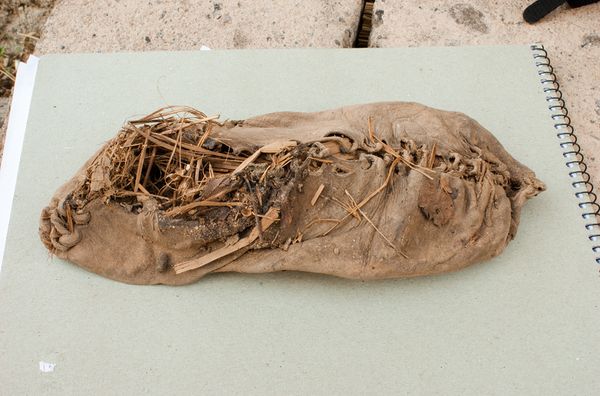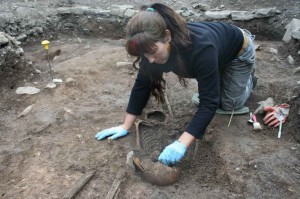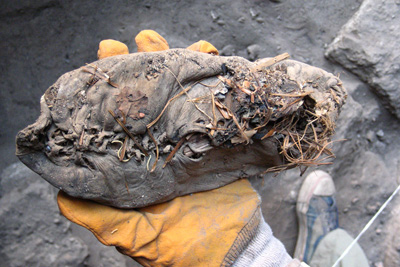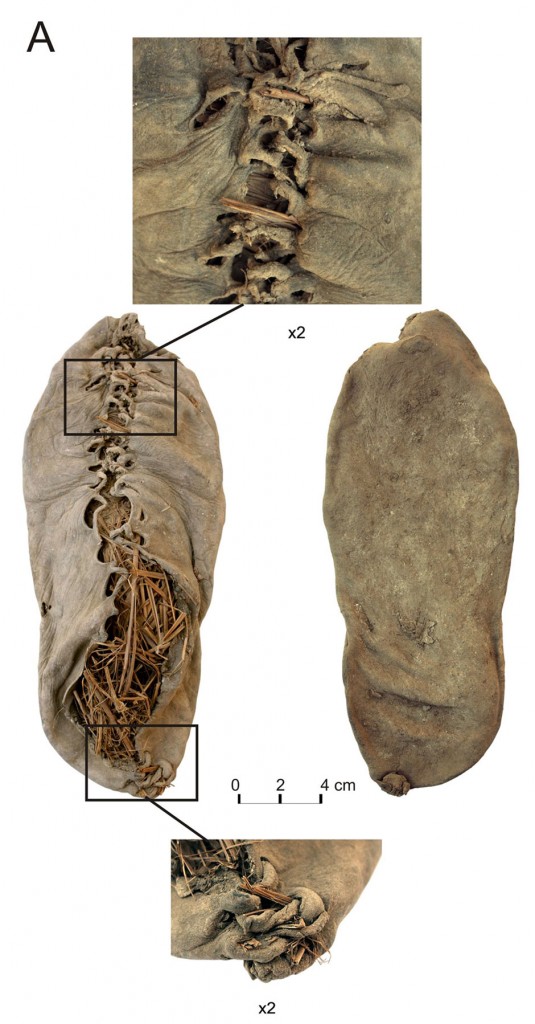The article below by Kate Ravilious, “World’s Oldest Leather Shoe Found—Stunningly Preserved“, was reported originally by the National geographic Daily News on June 9, 2010. about the world’s oldest leather shoe discovered in Armenia. The discovery of the world’s oldest known leather shoe was funded by the National Geographic Society, the Chitjian Foundation (Los Angeles), and Joe Gfoeller of the Gfoeller Foundation, the Steinmetz Family Foundation, the Boochever Foundation, and the Cotsen Institute of Archaeology.
Kindly note that a number of photos and the video did not appear in the original National geographic report.
=========================================================================
A Manolo Blahnik it isn’t.
Still, the world’s oldest known leather shoe, revealed Wednesday, struck one of the world’s best known shoe designers as shockingly au courant.
“It is astonishing,” Blahnik said via email, “how much this shoe resembles a modern shoe!”
Stuffed with grass, perhaps as an insulator or an early shoe tree, the 5,500-year-old moccasin-like shoe was found exceptionally well preserved—thanks to a surfeit of sheep dung—during a recent dig in an Armenian cave.
About as big as a current women’s size seven (U.S.), the shoe was likely tailor-made for the right foot of its owner, who could have been a man or a woman—not enough is known about Armenian feet of the era to say for sure.
 The world’s oldest known leather shoe (pictured) has been found in an Armenian cave, archaeologists say (Photo Source: Gregory Areshian & National Geographic Daily News).
The world’s oldest known leather shoe (pictured) has been found in an Armenian cave, archaeologists say (Photo Source: Gregory Areshian & National Geographic Daily News).
Made from a single piece of cowhide—a technique that draws premium prices for modern shoes under the designation “whole cut”—the shoe is laced along seams at the front and back, with a leather cord.
Ron Pinhasi, co-director of the dig, from the University College Cork in Ireland, explains:
“The hide had been cut into two layers and tanned, which was probably quite a new technology,” .
Yvette Worrall, a shoemaker for the Conker handmade-shoe company in the U.K., added:
“I’d imagine the leather was wetted first and then cut and fitted around the foot, using the foot as a last The end result looks surprisingly familiar for something so ancient—and not just to Blahnik. “It immediately struck me as very similar to a traditional form of Balkan footwear known as the opanke, which is still worn as a part of regional dress at festivals today,” said Elizabeth Semmelhack, a curator at the Bata Shoe Museum in Toronto, Canada. “I thought, Wow, not so much has changed.” Oldest Leather Shoe Shows Stunning Preservation Radiocarbon dated to about 3500 B.C., during Armenia’s Copper Age, the prehistoric shoe is compressed in the heel and toe area, likely due to miles upon miles of walking. But the shoe is by no means worn out. Shoes of this age are incredibly rare, because leather and plant materials normally degrade very quickly. But in this case the contents of a pit in the cave, dubbed Areni-1, had been sealed in by several layers of sheep dung, which accumulated in the cave after its Copper Age human inhabitants had gone. “The cave environment kept it cool and dry, while the dung cemented the finds in,” said Pinhasi, lead author of the new study, published by the journal PLoS ONE Wednesday. [Click to Enlarge] Close-up details of the leather shoe discovered in a cave in Armenia (Photo Source: GoodNews). The 5,500 year old (perfectly preserved) shoe, the oldest leather shoe of its type in the world, dates back to approx. 3,500 BC (Chalcolithic period). It was made of a single piece of leather and shaped to fit the wearer’s foot. The shoe is 1,000 years older than Egypt’s Great Pyramid of Giza. Why Was Oldest Leather Shoe Made? Protecting the foot was probably one of the main reasons people started wearing shoes, and certainly this seems the case for the world’s oldest leather shoe. Around the Armenian cave, “the terrain is very rugged, and there are many sharp stones and prickly bushes,” said University of California archaeologist and study co-author Gregory Areshian, who was partly funded by the National Geographic Society’s Committee for Research and Exploration. (The National Geographic Society owns National Geographic News.) Furthermore, shoes like this would have enabled people to cope with extremes of temperature in the region—up to 113°F (45°C) in summer and below freezing in winter—and to travel farther. “These people were walking long distances. We have found obsidian in the cave, which came from at least 75 miles [120 kilometers] away,” he said. Blahnik, the shoe designer, speculates that even this simple design was worn for style as well as substance. The leather shoe hand-held by a researcher at the excavation site. As noted in the UCLA Asia Institute report, the Armenian leather shoe was a European size 37 or women’s size 7. As noted Dr Ron Pinhasi, University College Cork, Cork, “as while small (European size 37; US size 7 women), the shoe could well have fitted a man from that era.” The shoe was found stuffed with grass (Photo Source: UCLA Asia Institute). “The shoe’s function was obviously to protect the foot, but I am in no doubt that a certain appearance of a shoe meant belonging to a particular tribe,” said Blahnik, who knows a thing or two about expressing identity through attire. “I am sure it was part of the outfit which a specific tribe wore to distinguish their identity from another.” Not the World’s Oldest Shoe Previously, the oldest known closed-toe shoes were those belonging to Ötzi, the “Iceman” found in the Austrian Alps in 1991, who died around 5,300 years ago. (See “Iceman Wore Cattle, Sheep Hides; May Have Been a Herder.”) Sandals meanwhile, have an even longer history, with the oldest specimens, dated to more than 7,000 years ago, discovered in the Arnold Research Cave in central Missouri. The wearing of shoes, though, is almost certainly older than the oldest known shoes. For example, a weakening of small toe bones found in 40,000-year-old human fossils has been cited as evidence of the advent of shoes. Compared to Ötzi’s shoes, the world’s oldest leather shoe is strictly bare-bones, according to Jacqui Wood, an independent archaeologist based in the U.K., who studied Ötzi’s shoes and who said the new study’s science is sound. “The Iceman’s shoe was in another league altogether,” Wood said. “Each base was made from brown bearskin; the side panels were deerskin; and inside was a bark-string net, which pulled tight around the foot…By contrast, the Armenian shoe is the most basic of shoes and was probably made worldwide once people decided not to walk about in bare feet.” (See pictures of the Iceman.) It’s true that similar shoes have been found at other sites and from other times, but study co-authors Pinhasi and Areshian think it’s plausible that the style originated in Armenia. Pinhasi notes: “Many other inventions, such as wheel-thrown pottery, cuneiform writing, and wool production evolved in the ancient Near East…And so Armenia may give us the earliest clues to a ‘prototype’ shoe, which later spread to Europe“. Rebecca Shawcross, a shoe historian at the Northampton Museums & Art Gallery in the U.K., said: “You can certainly make a case for this shoe [design] being a forerunner to the North American moccasin, which has gone on to be a popular shoe style, whose influences can be seen in shoes of today—deck shoes; soft, slipper-style shoes for men; and so on.” The “Astonishingly modern” shoe has been preserved by sheep dung, dryness and stable temperatures of the Armenian cave in which it was discovered. This invention of the shoe allowed humans to better protect their feet over rough terrain, against extreme heat and cold and to travel over longer distances. Beyond the World’s Oldest Leather Shoe With the moccasin mystery largely solved, the study team has plenty more puzzles to solve in Areni-1. Along with the shoe, the ancient sheep dung had sealed in the horns of a wild goat, bones of red deer, and an upside-down broken pot. Pinhsi said: “It is a strange assortment of items…and I wouldn’t be surprised if they have some symbolic meaning“—a meaning that could be revealed as summer, and a new dig season, dawns at Areni-1. A member of the research team at the excavation site in Armenia; the actual cave is situated in the Vayotz Dzor province of Armenia, on the Armenian, Iranian, Nakhichevanian and Turkish borders (Photo Source: GoodNews).
A member of the research team at the excavation site in Armenia; the actual cave is situated in the Vayotz Dzor province of Armenia, on the Armenian, Iranian, Nakhichevanian and Turkish borders (Photo Source: GoodNews).





